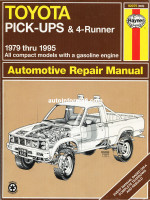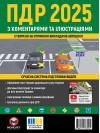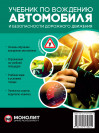Показать
2522
Toyota Pick-Ups / Toyota 4-Runner (Тойота Пикапс / Тойота 4Раннер). Руководство по ремонту, инструкция по эксплуатации. Модели с 1979 по 1995 год выпуска, оборудованные бензиновыми двигателями
Код товара:
5788
ISBN:
1-56392-151-0
Издательство:
Haynes Тип бумаги:
газетная
Язык:
английский
Кол-во страниц:
340
Переплет:
мягкий
Цветность:
черно-белая
Нет в наличии!
Цена:
150 грн.
7 usd.
6 eur.
Быстрая покупка
Данное руководство может стать замечательным подарком автомобилисту . Ведь недаром говорят, что книга это лучший подарок, а если она еще и поможет автомобилисту в ремонте, обслуживании и эксплуатации своего автомобиля, Вы можете быть безусловно уверены в полезности и актуальности своего подарка.
Обзор книги по ремонту Toyota Pick-Ups / Toyota 4-Runner
VIDEO
Содержание
Introductory pages
Tune-up and routine maintenance
Suspension and steering check
Whenever the front of the vehicle is raised for any reason, it's a good idea to visually check the suspension and steering components for wear.
Indications of steering or suspension problems include excessive play in the steering wheel before the front wheels react, excessive swaying around corners or body movement over rough roads and binding at some point as the steering wheel is turned.
Before the vehicle is raised for inspection, test the shock absorbers by pushing down agressively at each corner. If the vehicle doesn't come back to a level position within one or two bounces, the shocks are worn and should be replaced. As this is done listen for squeaks and other noises from the suspension components. Information on shock absorber and suspension components can be found in Chapter 10.
Raise the front end of the vehicle and support it on jackstands. Make sure it's safely supported!
Crawl under the vehicle and check for loose bolts, broken or disconnected parts and deteriorated rubber bushings on all suspension and steering components. Look for grease or fluid leaking from around the steering gear assembly and shock absorbers. If equipped, check the power steering hoses and connections for leaks. On 1986 and later 4WD models, check the balljoint dust covers and driveshaft boots for damage.
The balljoint seals should be checked at this time. This includes not only the upper and lower suspension balljoints, but those connecting the steering linkage parts as well. After cleaning around the ball-joints, inspect the seals for cracks and damage. Check the balljoints (2WD vehicles) for wear (see illustration) .
Check the suspension balljoints for wear by prying up on the tires as shown here — note that the lower control arm must be supported by a jackstand and the tire must be off the ground
Grip the top and bottom of each wheel and try to move it in and out. It won't take a lot of effort to be able to feel any play in the wheel bearings. If the play is noticeable it would be a good idea to adjust it right away or it could confuse further inspections.
Grip each side of the wheel and try rocking it laterally. Steady pressure will, of course, turn the steering, but back and forth pressure will reveal a loose steering joint. If some play is felt it would be easier to get assistance from someone so while one person rocks the wheel from side-to-side, the other can look at the joints, bushings and connections in the steering linkage.
To check the steering box, first make sure the bolts holding the steering box to the frame are tight. Then get another person to help examine the mechanism. One should look at, or hold onto, the arm at the bottom of the steering box while the other turns the steering wheel a little from side to side. The amount of lost motion between the steering wheel and the gear arm indicates the degree of wear in the steering box. Check the gearbox oil level as well. On 2WD models it should be about 1-inch from the top. On 4WD models it should be about 1/2-inch from the top. Refer to the Recommended lubricants and fluids section in the Specifications if oil is needed.
Moving to the vehicle interior, check the play in the steering wheel by turning it slowly in both directions until the wheels can just be felt turning. The steering wheel free play should be less than 1-1/8 inch. Excessive play is another indication of wear in the steering gear or linkage.
Following the inspection of the front, a similar inspection should be made of the rear suspension components, again checking for loose bolts, damaged or disconnected parts and deteriorated rubber bushings.
Другие книги по ремонту и обслуживанию автомобилей Toyota:
Компания Автоинформ







 В корзине!
В корзине!


